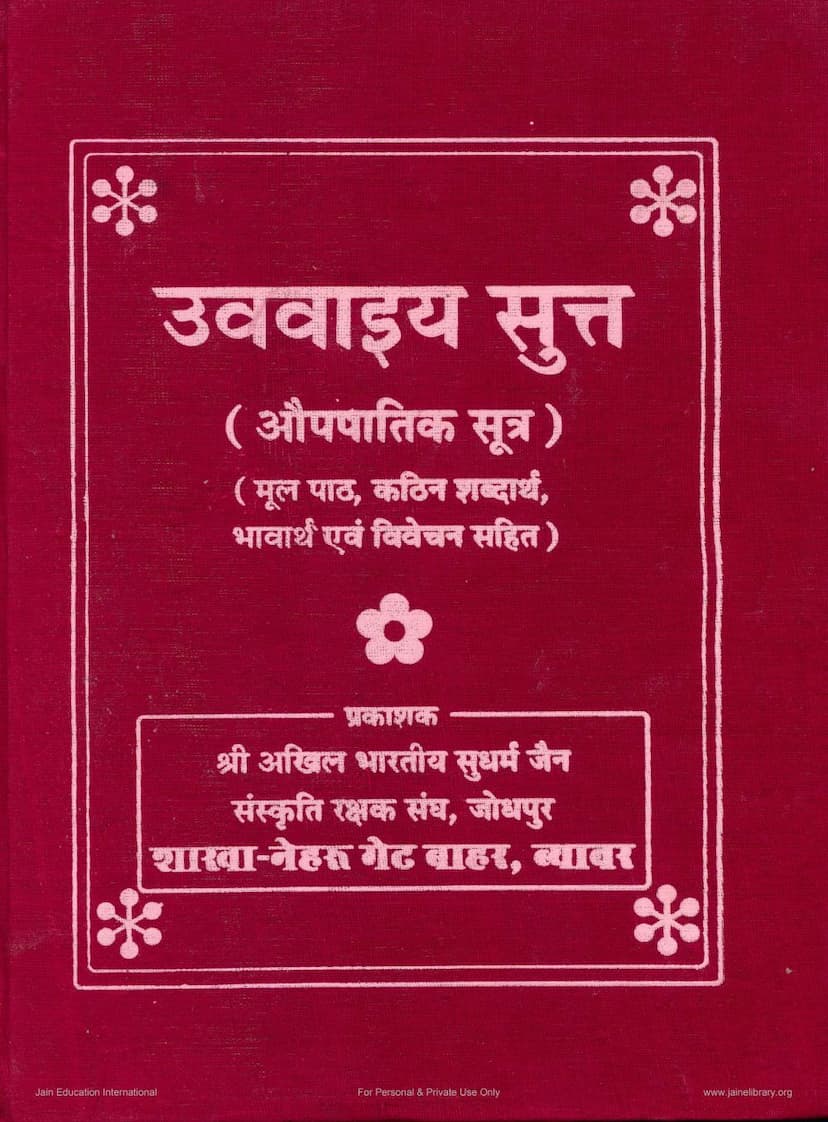Uvavaiya Sutra
Added to library: September 2, 2025

Summary
Here's a comprehensive summary of the Uvavaiya Sutra (औपपातिक सूत्र) based on the provided text:
Uvavaiya Sutra (The Sutra of Manifestation/Birth)
The Uvavaiya Sutra is identified as the first Upanga (secondary Anga) scripture within the Jain Agamic literature. Its primary significance lies in its detailed exposition of the concept of "Upapata," which refers to the birth or manifestation of beings, particularly in the realms of hell-dwellers (Narakas) and celestial beings (Devas). It is considered an Upanga of the Acharaanga Sutra due to its thematic proximity, expanding upon the soul's manifestation (Upapata bhava) alluded to in the Acharaanga Sutra.
Structure and Key Themes:
The Sutra is broadly divided into two main sections:
- Samavasarana Vibhaga: This section describes the divine assembly (Samavasarana) where Lord Mahavir delivers a sermon.
- Upapata Vibhaga: This section delves into the detailed discussion of the birth or manifestation of beings in different realms, answering questions posed by Ganadhara Gautama.
Major Contents and Highlights:
-
Detailed Description of Champanagari: The text begins with a vivid and elaborate description of the city of Champa, detailing its prosperity, architecture, infrastructure, marketplaces, gardens, and the general well-being and activities of its inhabitants. This paints a picture of the socio-economic and cultural landscape of the time.
-
The Fullabhadra Chaitya: A significant portion is dedicated to describing the Fullabhadra Chaitya, an important religious site located outside Champa. The description emphasizes its ancient origins, grandeur, artistic embellishments, and the reverence it commanded from the populace.
-
The Ashok Tree and the Stone Slab: The text meticulously describes a magnificent Ashok tree situated within a sacred grove surrounding the Fullabhadra Chaitya, and beneath it, a beautifully described stone slab, highlighting the aesthetic and spiritual significance of these natural elements.
-
King Konika's Devotion: The Sutra extensively details King Konika's (Ajatashatru) profound devotion to Lord Mahavir. It mentions his establishment of a dedicated department to monitor Lord Mahavir's daily activities, a testament to his deep reverence and commitment.
-
Lord Mahavir's Glorious Form and Disciples: The text provides an unparalleled detailed description of Lord Mahavir's physical attributes and the characteristics of his disciples, highlighting their spiritual radiance, knowledge, asceticism, and possession of various psychic powers (Laddhis).
-
The Samavasarana and Lord Mahavir's Sermon: The arrival of Lord Mahavir in Champanagari, the message conveyed to King Konika, the indirect obeisance by the King, the arrival of celestial beings, the establishment of the Samavasarana, the King's family attending the sermon, and Lord Mahavir's discourse on the conduct of ascetics (Shramanachara) and householders (Shravakachara) are described in detail.
-
The Upapata Inquiry: Following the Samavasarana, Ganadhara Gautama poses a series of profound questions to Lord Mahavir concerning the causes of karmic bondage, the transmigration of souls based on their conduct, and the specific circumstances leading to births in various life forms (Yonis).
-
Detailed Solutions to Upapata Questions: Lord Mahavir provides comprehensive answers to Gautama's queries, covering the nature of various beings like ignorant individuals, those with disturbed minds, noble souls, hermits, mendicants, heretics, followers of different philosophical schools (Ajivikas, Nihavas), sentient beings with five senses, minimally harming humans, and ascetics who cause no harm.
-
The Case of Ambada Parivrajaka and his Disciples: The Sutra includes a detailed narrative about Ambada Parivrajaka and his 700 disciples, their lineage, their profound knowledge, their austerities, their miraculous powers (Viriya Labdhi, Vikriya Labdhi, Avadhi Jnana), their ultimate renunciation, and their subsequent rebirths.
-
Kevali Samudghata and Siddhas: The text explains the causes and nature of Kevali Samudghata (the process by which an omniscient being, during his lifetime, expands his soul-substance to encompass the entire universe). It also describes the nature of liberated souls (Siddhas), their abode (Siddha-shila), and their eternal state.
Significance and Uniqueness:
- Comprehensive Description: The Uvavaiya Sutra is renowned for its expansive and detailed descriptions of various subjects, making it a foundational text for understanding many aspects of Jain cosmology, history, and societal practices.
- Source for Other Agamas: The detailed explanations within the Uvavaiya Sutra often served as references for Anga scriptures like the Bhagavati Sutra, which would simply allude to the Uvavaiya Sutra for further information on certain topics.
- Historical and Societal Insights: It offers valuable insights into the social, political, economic, religious, and philosophical conditions of ancient India.
- Linguistic Simplicity: The language used in the Sutra is described as simple and engaging, making it accessible to a wider audience.
In essence, the Uvavaiya Sutra is a treasure trove of Jain knowledge, particularly focusing on the intricate processes of transmigration and the divine assembly, providing rich descriptions of places, people, and spiritual concepts.